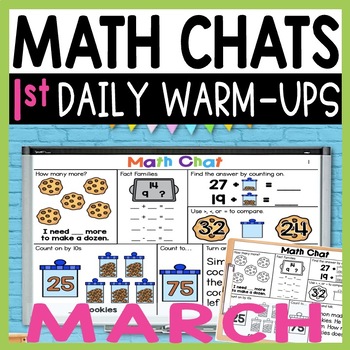Daily Math Review for 1st Grade, Spiral Review Math Warm Ups for March
Deanna Jump
109.2k Followers
Grade Levels
1st
Subjects
Resource Type
Standards
CCSS1.NBT.A.1
CCSS1.NBT.B.2
CCSS1.NBT.B.2c
CCSS1.NBT.B.3
CCSS1.OA.A.1
Formats Included
- Zip
Pages
60+
Deanna Jump
109.2k Followers
Also included in
- Are you a first grade teacher looking for daily math warm ups? Math Chat Messages are the perfect warm up and spiral review exercises for your daily 1st grade math instruction. Each day, you'll be equipped with a new and exciting math activity that will captivate your students' attention.★ EffortlPrice $35.00Original Price $51.50Save $16.50
Description
Are you looking for daily math warm-ups for first grade? These spiral review Math Chat messages for March are designed to be used as a whole group math talk to kick off your daily math lessons. They are a great way to review a variety of skills in a short amount of time. Let your students practice math skills each day with these digital and printable morning messages. The turn and talk question/problem is also available in journal format.
Skills include: fact families, counting on and counting back, tally marks, story problems, place value, number bonds, making 10, composing & decomposing numbers, greater than/less than/equal to and more!
Also available in a MONEY SAVING BUNDLE
SKU: 3665447
Total Pages
60+
Answer Key
N/A
Teaching Duration
1 month
Report this resource to TPT
Reported resources will be reviewed by our team. Report this resource to let us know if this resource violates TPT’s content guidelines.
Standards
to see state-specific standards (only available in the US).
CCSS1.NBT.A.1
Count to 120, starting at any number less than 120. In this range, read and write numerals and represent a number of objects with a written numeral.
CCSS1.NBT.B.2
Understand that the two digits of a two-digit number represent amounts of tens and ones. Understand the following as special cases:
CCSS1.NBT.B.2c
The numbers 10, 20, 30, 40, 50, 60, 70, 80, 90 refer to one, two, three, four, five, six, seven, eight, or nine tens (and 0 ones).
CCSS1.NBT.B.3
Compare two two-digit numbers based on meanings of the tens and ones digits, recording the results of comparisons with the symbols >, =, and <.
CCSS1.OA.A.1
Use addition and subtraction within 20 to solve word problems involving situations of adding to, taking from, putting together, taking apart, and comparing, with unknowns in all positions, e.g., by using objects, drawings, and equations with a symbol for the unknown number to represent the problem.






